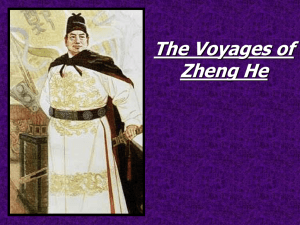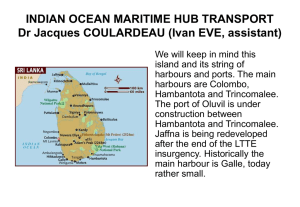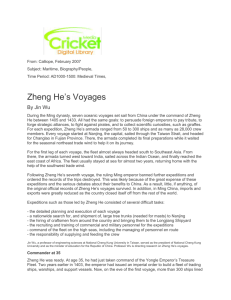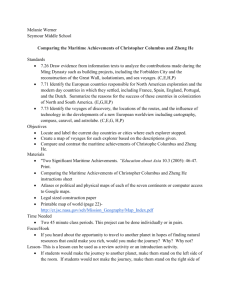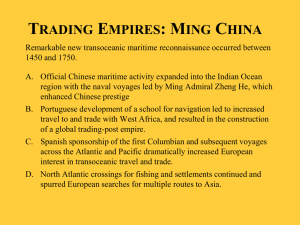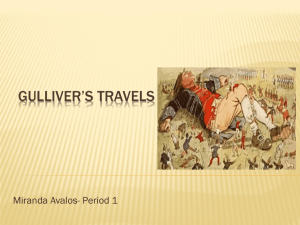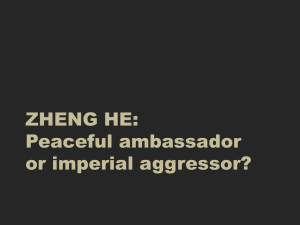The Voyages of Zheng He - Arizona Geographic Alliance
advertisement
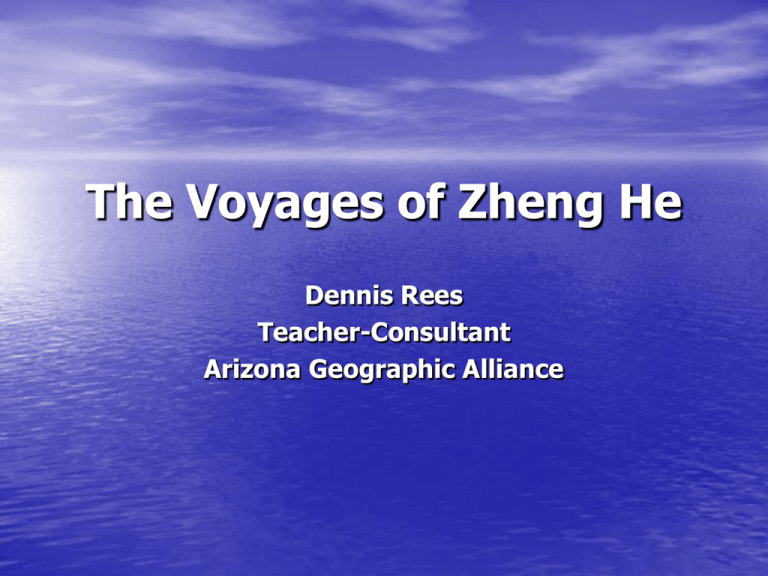
The Voyages of Zheng He Dennis Rees Teacher-Consultant Arizona Geographic Alliance From 1405 until 1433, Admiral Zheng He made 7 voyages. The purpose of the voyages was to establish trade and diplomatic relations between China and nations in Southeast Asia, South Asia, and the Arabian Peninsula. The fleets ranged in size from 48 to 317 ships carrying 27,000 to 30,000 sailors, soldiers, merchants, and scholars. The ships used maps, star charts, and compasses to navigate the open seas. It is the first fleet in history to not hug the coast as a means of guidance. They took silk, porcelain, and copper coins to trade for spices, gems, fragrant woods, animals, textiles, and minerals. Throughout each voyage, detailed maps were made, information gathered on the climate and cultures encountered, and plant and animal specimens were collected. The first voyage, 1405-1407, visited Champa (central Vietnam), Java, Sumatra, Malacca, Ceylon, and Cochin and Calicut in India. Impressed with China’s wealth and power, local rulers sent ambassadors back with the fleet to pay tribute (money and goods) to the emperor. Also on the way home, Zheng He’s fleet destroyed the pirate fleet in the Strait of Malacca, thus restoring safe passage to all ships in the region. The second (1407-1409) and third (1409-1411) voyages returned to the same areas and to some new ones, including Siam (Thailand). Ambassadors were returned home, and diplomatic and trade relations strengthened. During the third voyage, when the king of Ceylon attacked the fleet, Zheng He defeated and captured him. It was also on the third voyage that Zheng He erected this tablet in Ceylon honoring Buddha. The inscription is written in Chinese, Tamil, and Persian. The fourth voyage, 1413-1415, reached Hormuz and Aden on the Arabian Peninsula. These two ports controlled the rich trade routes of the Persian Gulf and the Red Sea. He returned home with riches from Arabia and Africa, and more ambassadors. The fifth voyage, 1416-1419, returned to the places in Southeast Asia, Ceylon, India, Hormuz, and the Arabian Peninsula that had been visited before. The fleet also sailed down the east coast of Africa making stops at Mogadishu and Malindi. He returned home with exotic animals and African ambassadors. So many exotic animals were arriving in China due to the voyages that the emperor created a special garden to house them , China’s first zoo. The sixth voyage, 1421-22, returned ambassadors to various countries, but concentrated on the Arabian Peninsula and East Africa. Emperor Zhu Di died shortly after this voyage. His son decided to suspend the voyages during his brief reign. The next emperor, Zhu Di’s grandson, decided to resume the voyages. He called upon Zheng He to once again lead the fleet. The seventh voyage, 1430-1433, revisited Champa, Java, Sumatra, Malacca, Ceylon, Calicut, and Hormuz. In Hormuz, Zheng He split his fleet. Part of it continued on to Aden and then the Red Sea port of Jiddah. From Jiddah, a delegation traveled to Mecca. Another part sailed down the east coast of Africa. The remainder returned to China. On the way, Zheng He died and was buried at sea. With Zheng He’s death, the voyages ended and the fleet was dispersed. Over the course of 28 years, they had restored China’s diplomatic and trade relations, freed the ocean routes from Asia to India and Arabia of pirates, and established Chinese communities that exist today in many of the places they had visited.
